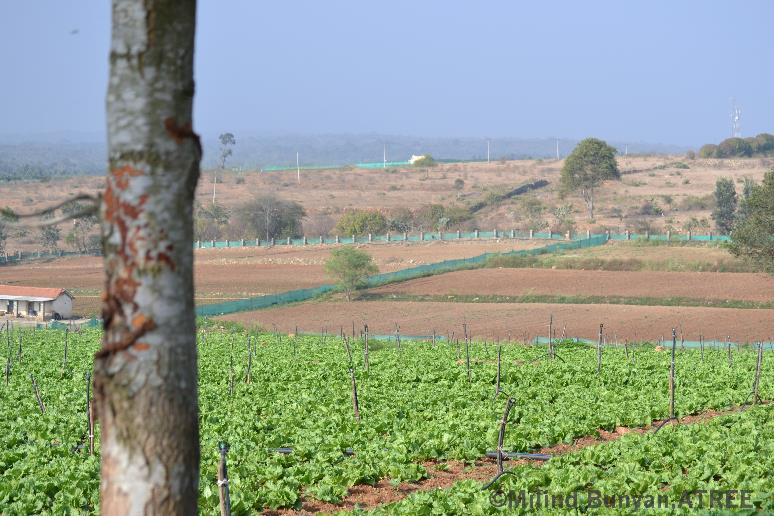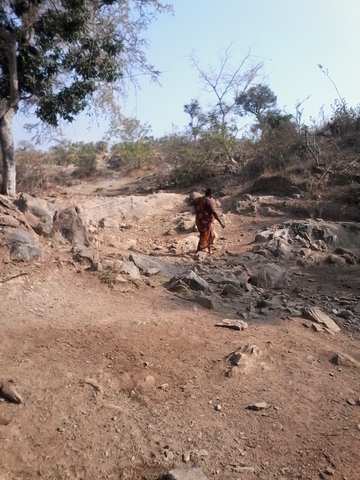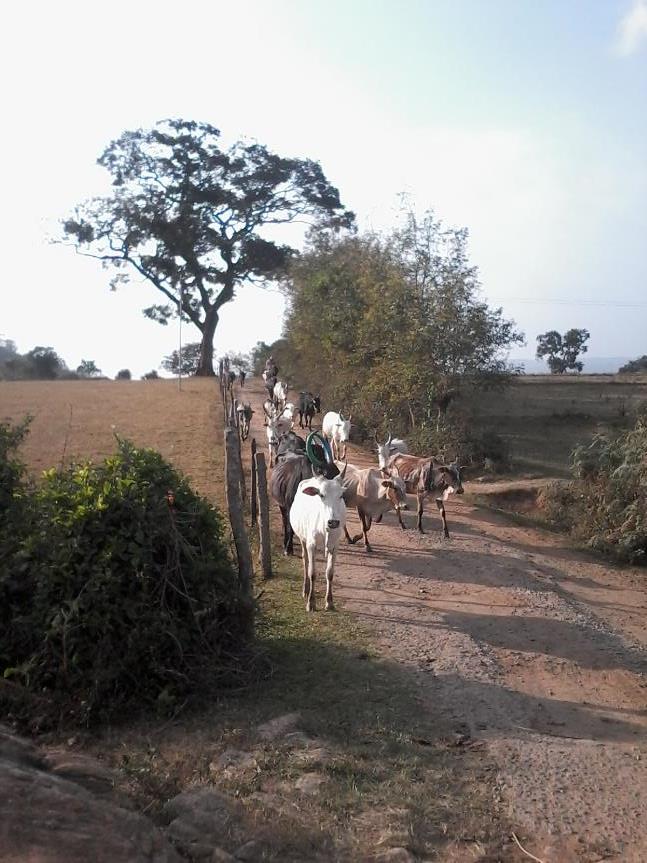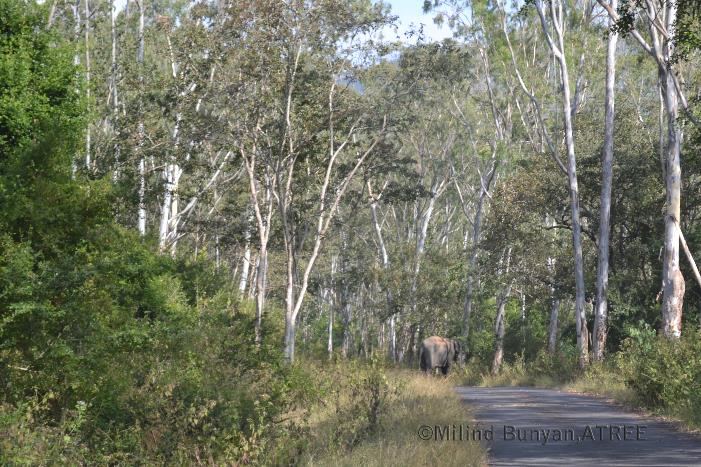Field Experiences in the Moyar-Bhavani Sub-region, India

By Divya Solomon
ATREE (Milind Bunyan, Hussain Ebrahim and Divya Solomon) visited the Moyar-Bhavani river basin in southern India as part of a scoping exercise to understand the landscapes and communities living within the sub-region in December 2014. The Moyar-Bhavani basin is a large diverse landscape with a wide variety of tribal and non-tribal communities. While it comprises 120 villages, ATREE has been undertaking scoping studies to understand salient characteristics of these villages and inform site selection for situating ASSAR research. During these visits, we typically conduct informal interviews with villagers and government officials, and make an attempt to create a photographic journal of landscapes to construct an overview of how biophysical and social aspects of the landscape interact.
Tourism Takeover
We conducted a field visit in the Moyar side of the transect in December 2015. Our visit began in the village of Semmanatha in the Nilgiris district and is located within the Mudhmulai Tiger Reserve. It is visibly surrounded by a large number of privately owned guesthouses and resorts.

Map of field sites visited. Prepared by Manish Gautam, IIHS
The villagers are primarily from the Irula Tribe, a Scheduled Tribe of India (as defined by India's constitution). The Irulas have lived in these areas as hunter-gatherers for centuries. They were jungle-dwellers, which gave them their name “Irula” or “people of the darkness”. The largest tribal population is found in India and they constitute nearly 8% of the Indian total population. One of the largest tribes in Tamil Nadu is Irulas. They are mainly found in forested areas of Tamil Nadu but have also drifted to hilly areas in Kerala. They have been facing severe socio-economic problems over the last two decades, primarily due to livelihood shifts and changing community structures. Many of them have migrated to peri-urban areas in search of livelihoods, which has alienated them from their communities and resulted in them living in extreme poverty.

"Irulas, 1871" by unknown photographer from the Madras School of Arts - Licensed under Public Domain via Wikimedia Commons
Through our discussions with villagers, we found that landholdings in Semmanatha were relatively fewer than those in other tribal villages of the area. The villagers explained that previously the primary livelihood of the community was settled agriculture and livestock products. However, over the last decade, this area has emerged as a prime destination for wildlife tourism. Consequently, people from surrounding cities in Tamil Nadu and Kerala approached villagers with offers to buy their agricultural land. Most villagers felt it would be more lucrative to sell their land than continue with cultivation because of the unpredictability of agriculture as a source of income. As a result, most of the villagers sold their land far below market rates. Private as well as commercial guesthouses mushroomed as tribal people shifted out of agriculture. Presently, the primary livelihood in the village is pastoralism; almost all households own livestock or small ruminants, which graze in surrounding forestlands. Pasturing in forestlands is fraught with danger for both the animals and the herders because attacks by wildlife (leopards and tigers) is common. The forest department does not pay compensation for attacks that occur within forestland as grazing in these areas is prohibited by law. As a result, villagers frequently suffer debilitating losses, increasing their dependence on government aid, particularly food rations. Recent initiatives of NGOs have inspired villagers to reclaim their land, which they claim they were cheated out of. The case has been presented in a lower court of law, the verdict of which is yet to be decided.
Given this background of conflict and changing livelihoods, understanding how such livelihood dynamics and their associated socio-economic implications interact with climatic variability and shapes climate change adaptation, would be an interesting question to answer through ASSAR.

Irrigated agriculture in an arid landscape. Photo by Milind Bunyan
Tenacious tribals
After Semmantha we proceeded towards the Karnataka border, visiting several small villages and hamlets along the way. Most farmers engaged in rainfed agriculture, while some large landholders owned borewells and practiced irrigated agriculture as well. The major hurdle to agriculture reported in these areas was human-wildlife conflict. Farmers reported extensive losses due to crop damage by elephants and wild boards, apart from regular losses due to rainfall deficits.
We then continued along the northern part of the transect towards the west to visit some remote tribal villages located in the core zones of the Sathyamangalam Tiger Reserve. Our first stop was in the tribal village of Belajatti. Initial observations of this picturesque village suggested that it had basic government facilities and was relatively prosperous. The village had a primary health centre, primary school, and water tank. The houses where mostly brick structures and most villagers practiced agriculture in small fields leased to them by the government. However, on speaking to some villagers, we learnt that the village was nearly deserted, with the only people visible being small children.
On further investigation, we were informed by a village elder that all the adults had gone to the forests where they would stay for up to a month to collect Non-Timber Forest Products (NTFPs) such as honey, broom weeds, fruits and berries. The villager explained to us that these activities were fraught with peril. Only a few months before two villagers returning home from the forest were killed by a tiger. However, the villagers still visit the forests as they play a vital role in their livelihoods. The villagers sold the collected produce to agents or organisations such as Keystone Foundation, that process and market these products. Thus, NTFP collection is a lucrative source of supplementary income particularly during the lean summer months.

Woman collecting water in the forest near Belajatti. Photo by Hussain Ebrahim
In order to understand the state of agriculture in the area we spoke to some villagers. Yelchettappa, a village elder, explained the reasons behind crop failure in the area: “We have been farming successfully in this difficult land for hundreds of years. However, now farmers put chemicals in everything. They even buy seeds from the shops. These ‘outside’ varieties cannot withstand our harsh climate. Now the weather is also becoming worse as there are less rains and the seasons are more irregular. I don’t know how long we can survive in this area.” He also suggested that a new invasive species might be affecting NTFP production in the forest. Although he described the plant to us, we were unable to identify it and left with our curiosity piqued.
Tusker troubles
We followed the road deeper into the forest towards a tribal hamlet called Ittarai. The hamlet was located on an elevated plateau with a view of the valley below and consisted of about 25 households. However, it had a surprisingly large number of livestock and large land holdings. Interviews revealed that they were able to maintain such large cattle holdings because of large streams situated near the village. All pasturing was done within the forest. Although this practice is illegal, it seemed to be tolerated by the forest guards. Being more remote and closer to the forest, reports of elephant troubles were more pronounced. In fact, villagers said they do not grow banana plants for fear of attracting elephants.
The farmers in this village do not use chemical fertilizers or pesticides. They only use manure, which they obtain from their livestock. Conflict with wildlife from the surrounding forest areas posed was a prominent threat to agriculture in this village. Elephant herds would regularly raid crop fields often destroying an entire season’s crop. Consequently, farmers are forced to liquidate assets (usually cattle) in order to provide for their households. These are often distress sales and result in below-market prices of cattle.
In order to mitigate this problem farmers have resorted to growing low-value crops such as millets, which do not attract wildlife. However, this has resulted in low profits for farmers, exacerbating poverty. Compounding this problem is erratic rainfall, which according to local farmers, has become more intense over the last ten years. As all the crops in this area are rainfed, changes in rainfall patterns severely effect crop productivity and yields. Rainfall deficits and drought conditions have had a severe impact on household well-being and livestock health in the area. Furthermore, in months of low rainfall, the chance of wildlife raiding crops increases exponentially. The remoteness of the area contributes to existing problems because the villagers are often excluded from government aid and facilities. Ittarai highlighted the complex interdependence of tribals with their natural surroundings demonstrating how small disturbances in natural systems can have resounding effects on tribal livelihoods.

Cattle in Ittarai village. Photo by Hussain Ebrahim
This village highlighted the complex interdependence of tribals and their natural surroundings. Ittarai could be an interesting site of study because of the strong climate dependency of livelihoods in the area as well as the complex relationship of the community with the surrounding forest area.

Elephant crossing near Ittarai village. Photograph by Milind Bunyan
Our scoping visit was particularly insightful. We visited communities that seemed to be vitally dependent on climate-sensitive livelihoods. Some of these communities managed to thrive in their harsh surroundings with minimal institutional dependence, while others seemed to be barely surviving. The visit helped to establish a preliminary understanding of tribal livelihood systems in the area, which will contribute towards shaping our research questions as we move into the research phase of ASSAR. Although this field visit was quite brief, more rigorous studies will be implemented based on these initial observations.